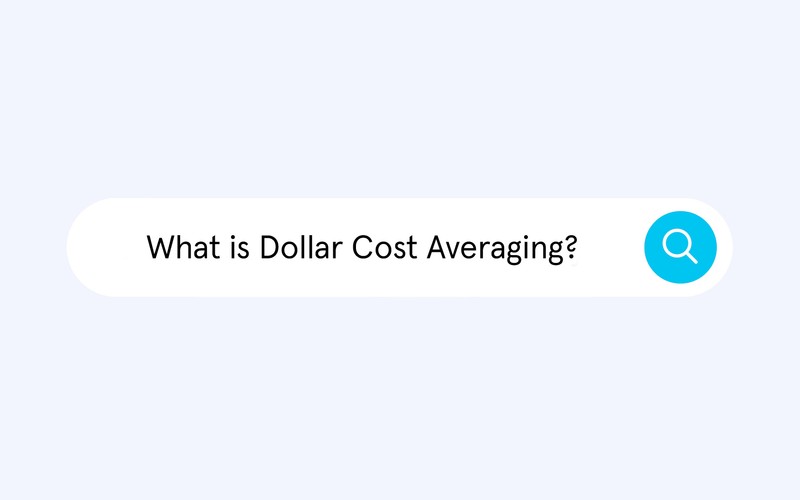When most people think about investing, they think about making a one-time lump sum investment and watching their money grow over time. While this is possible, it’s also risky. For example, what happens if the market crashes after you invest? You could lose a lot of money.
Dollar-cost averaging – also known as DCA – helps take the risk out by allowing you to spread your investment over time. This strategy eliminates the effort to time the market to buy at the best share prices. It’s also an excellent way for beginning investors to start the market. It’s simple to do, and it doesn’t require any special knowledge or skills. Plus, it’s an excellent strategy for building your brokerage account, retirement account, IRA, real estate investing account, or any investment product, for that matter, slowly and steadily over time, which is key to successful long-term investing.
In this article, we’ll look at how dollar-cost averaging works and the pros and cons.
How dollar-cost averaging works
There are two main ways to invest: lump sum and dollar-cost averaging. You invest a large sum of money at once with lump sum investing. However, doing so can be risky because if the market declines shortly after you make your investment, you could lose a significant amount of money in a short period of time.
The main principle behind dollar-cost averaging is that you reduce your risk of loss by buying securities over a period of time instead of all at once. When you invest a lump sum into a security, you are more likely to buy when prices are high and suffer losses when stock prices fall. However, when you use dollar-cost averaging, you spread your investment out over a long period so that you buy more securities when prices are low and fewer securities when prices are high. This gives you an average cost and reduces your risk of loss.
DCA can also help reduce the risk of timing the market because it takes the emotion out of investing. When you dollar-cost average, you buy a fixed amount or number of shares of an investment at regular intervals, regardless of the share price or your previous purchase price. Over time, this technique can help you lower your overall cost basis and boost your potential returns.
Dollar-cost averaging can be used with any investment, including stocks, mutual funds, ETFs, cryptocurrency, and shares of rental homes and vacation rentals.
Example of dollar-cost averaging
There are two ways to implement dollar-cost averaging: manually or through automated investing. With manual investing, you decide how much money you want to invest and then make periodic investments at regular intervals. With automated investing, you set up an account with a brokerage or financial institution and then set up automatic payments to be made at regular intervals from your bank account. The broker or financial institution will then use those funds to make stock market investments on your behalf.
For example, assume an investor wants to invest $100 per month on the first day of every month in a particular asset. They would buy shares every month at the prevailing share price. Let’s say an investor buys 10 shares for $10 each in January. The total investment is $100. In February, the share price dropped to $8, and the investor bought 12.5 shares. In March, the share price goes up to $9, and the investor buys 11.1 shares.
Over the course of three months, an investor who contributes $100 per month to their investment account and experiences share price fluctuations will have purchased a total of 33.6 shares for about $300 at an average price of about $8.92 per share ($300 / 33.6 shares = $8.92 / share). By comparison, had an investor purchased 30 shares in one lump sum of $300 for $10 each, the average price per share would be $10.
Even though the share prices have fluctuated monthly, the dollar-cost averaging strategy has helped reduce the risk associated with these fluctuations. This is because the buyer has averaged out their costs by buying more shares when prices are low and fewer when prices are high.
Dollar-cost averaging is a simple and effective way to invest in volatile markets. It is an excellent strategy for new investors who have just opened their brokerage account or retirement account and experienced investors who want to reduce their risk. By investing a fixed sum of money at regular intervals, investors can take advantage of fluctuations in the market and boost their potential returns over time.
Benefits of dollar-cost averaging
Dollar-cost averaging is a strategy that can make it easier to deal with uncertain markets by making purchases automatic. It also supports an investor’s effort to invest the same amount of money regularly. This strategy effectively eliminates the effort required to attempt to time the market to buy at the best prices. Dollar-cost averaging is one of the most straightforward techniques to boost your returns without taking on additional risk, and it’s a great way to practice buy-and-hold investing.
One advantage of dollar-cost averaging is that it takes the emotion out of investing. When you make regular investments regardless of what is happening in the market, you take away the temptation to try to time the market. This can help you avoid making decisions based on fear or greed, leading to investment mistakes.
Another benefit of dollar-cost averaging is that it forces you to buy more when prices are low and less when prices are high. Over time, this can lead to an increase in your overall returns. In addition, dollar-cost averaging can help reduce the effects of volatility on your portfolio.
Use volatility to your advantage
Market volatility, or sudden changes in asset prices due to market conditions, can pose a significant risk for investors. In periods of high volatility, the value of a portfolio can rapidly drop alongside declining markets. For example, going back to our lump-sum investing example, had an investor purchased 300 shares for $10 each and the price subsequently fell to $5, the investor would be sitting on a paper loss of $150 or a 50% decline in portfolio value.
However, market volatility can be a double-edged sword that you can use to your advantage. While periods of high volatility can lead to short-term losses, they also present opportunities for potential gains. Savvy investors can also use this same volatility to buy assets at a lower price and then sell them at a higher price later. This is where dollar-cost averaging can be useful. By consistently investing a set amount of money over time, regardless of market fluctuations, investors can take advantage of periods of lower prices and boost their returns.
Ultimately, market volatility requires careful monitoring and strategic decision-making from investors. It may be uncomfortable at times, but properly managed, it can pay off in the long run. By making regular investments, you can smooth out the market’s ups and downs, making it easier to stick to your investment plan.
Of course, it’s important to remember that even with dollar-cost averaging, risks are still involved. It’s wise for investors to put only some of their eggs in one basket and diversify their holdings across different asset classes and industries.
Drawbacks to dollar-cost averaging
The main disadvantage of dollar-cost averaging is that it doesn’t take advantage of market timing. If you believe the market will go up, there may be better strategies than dollar-cost averaging.
With dollar-cost averaging, you’re buying the same dollar amount of an investment at regular intervals, regardless of the share price. If the market rallies shortly after you start investing, you could miss out on some potential gains. For example, using the same $300 amount, if an investor purchased 60 shares at $5 and the share price rallied to $8, the paper gain would be $180 or a 60% gain in portfolio value.
Another potential drawback of dollar-cost averaging is that it can take a long time to build up a position in an investment if you’re starting with a small amount of money. For example, let’s say you have $1,000 to invest and you want to dollar-cost average into an asset. If you invest $100 per month, it will take you ten months to build up the desired position.
If you’re dollar-cost averaging into an investment, keep your time horizon and goals in mind. And as with any investment strategy, there are potential pros and cons that you should be aware of before you start using this technique.
Is dollar-cost averaging right for you?
If you’re an investor who tends to worry about timing the market perfectly, then dollar-cost averaging may be a good strategy. It can help take the guesswork out of investing and allow you to focus on other aspects of your financial plan. In addition, this approach helps mitigate the risk of buying at a high price point and can lead to long-term success, provided that the investor remains consistent and disciplined in their contributions.
That said, something other than dollar-cost averaging may be better suited for short-term investors or those looking to turn a profit quickly. In terms of financial capacity, there is no set amount required to start investing with this strategy. The key is to begin regularly contributing with whatever amount you can afford, whether it’s $50 per month or $500 per month. It depends on the individual’s financial situation and goals.
As for who could benefit most from dollar-cost averaging, it works well for young investors just starting, as they have time on their side for potential growth to offset any dips in the market. It can also serve as a helpful supplement to an already diversified portfolio.
Closing thoughts
Ultimately, assessing your investment goals and risk tolerance is essential before deciding if dollar-cost averaging is right for you. While it may not be the most glamorous or exciting investment strategy, dollar-cost averaging can provide stability and consistency in uncertain markets.
This method can be a reliable option for those who are less comfortable taking risks or don’t have time to monitor the market constantly. Whether you invest manually or set up automated investing, dollar-cost averaging can be a simple but effective way to reduce your investment risk and protect your portfolio from market fluctuations.
Start dollar-cost averaging in real estate today
Dollar-cost averaging can be an intelligent investment strategy, especially regarding real estate. Investing small amounts at regular intervals can help mitigate the risk of buying at a high point and potentially losing value.
Browse available investment homes today and see how your initial investment could grow over the next few years.







